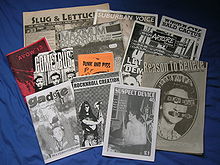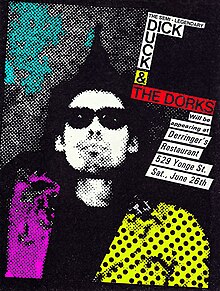Punk visual art


Punk visual art is artwork associated with the punk subculture and the No wave movement. It often graces punk rock album covers, flyers for punk concerts and punk zines. It is sometimes showcased in art galleries and exhibition spaces. Indeed, the punk aesthetic was a dominant strand from 1982 to 1986 in the many art galleries of the East Village of Manhattan.
Punk Aesthetics[]
The main aesthetic of punk visual art is to shock and/or perplex the viewer so as to create a sense of challenge, empathy, or revulsion in viewers; often by using acidic or sarcastic wit. Characteristics associated with punk art is the usage of black or gray colors, and letters cut out from newspapers and magazines: a device previously associated with Dada collage and kidnap ransom notes. A prominent example of that style is the cover of the Sex Pistols' Never Mind the Bollocks album designed by Jamie Reid. Images and figures are also sometimes cut and pasted from magazines and newspapers to create a collage.
Los Angeles artist Mark Vallen has said:
Punk had a unique and complex aesthetic. It was steeped in shock value and revered what was considered ugly. The whole look of punk was designed to disturb and disrupt the happy complacency of the wider society. Outside of punk's torn and safety pinned anti-fashion statements, this impulse to outrage was never more apparent than on punk album covers.[1]
Punk Art in New York[]
In New York City in the mid-1970s, there was much overlap between the punk music and the No wave downtown art scene. In 1978, many of the visual artists who were regulars at Tier 3, CBGB and other punk-related music venues participated in punk art exhibitions in New York.[2] Early punk art exhibits included the Colab organized The Times Square Show (1980)[3][4][5][6] and New York New Wave at PS1 (1981). Punk art found an ongoing home on the New York's lower east side with the establishment of ABC No Rio Gallery in 1980.[7]
See also[]
- Just Another Asshole
- No wave cinema
- Noise music
- Postmodern art
- Punk subculture
- Solarpunk
References[]
- ^ "A visual survey of early Punk Rock Album Covers," Essay by artist, Mark Vallen, Art-for-a-change.com
- ^ Masters, Marc (2007). No Wave. London: Black Dog Publishing. ISBN 978-1-906155-02-5
- ^ Goldstein, Richard, The First Radical Art Show of the '80s, Village Voice 16, June 1980, pp. 31-32
- ^ Levin, Kim, The Times Square Show, Arts September 1980, pp. 87-90
- ^ Deitch, Jeffrey, Report from Times Square, Art in America September 1980, pp. 58-63
- ^ Sedgwick, Susana, Times Square Show, East Village Eye Summer 1980, p. 21
- ^ Lippard, Lucy, Sex and Death and Shock and Schlock: A Long Review of The Times Square Show, by Anne Ominous in Post-modern Perspectives: Issues in Contemporary Art Ed. Howard Risatti. Englewood Cliffs, NJ: Prentice-Hall, 1990, pp. 77-86
Further reading[]
- Alan Moore and Marc Miller, eds., ABC No Rio Dinero: The Story of a Lower East Side Art Gallery, NY, Colab, 1985
- Masters, Marc (2007). No Wave. London: Black Dog Publishing. ISBN 978-1-906155-02-5.
External links[]
- 98 Bowery: 1969-1989 - catalogue for a 1978 exhibition at the Washington Project for the Arts
- Everything's Punk in This Pop-Up Art Show - review of the 2016 exhibition at the Invisible Dog
- Artist groups and collectives
- Contemporary art
- Visual arts genres
- Art movements
- Punk